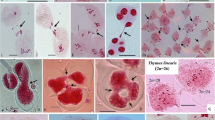Abstract
Meiotic chiasmata were analysed in metaphase I pollen mother cells (PMCs) of wild-type Arabidopsis thaliana and in two meiotic mutants. Fluorescence in situ hybridisation (FISH) with 45S rDNA and 5S rDNA as probes was used to identify the five chromosome pairs. A wild-type chiasma frequency of 9.24 per cell was found, consistent with estimated genetic recombination values. Individual bivalent chiasma frequencies varied according to chromosome size; chromosome 1 had the highest mean chiasma frequency (2.14) while the short acrocentric chromosomes had the lowest frequencies (1.54 and 1.56). FISH analysis was extended to two meiotic mutants (asy1 and dsy1) having low residual bivalent and chiasma frequencies. Mutant dsy1 gave no indication of chromosome preference for residual bivalent formation; instead it showed a general reduction in bivalent and chiasma frequencies. In asy1, the longest chromosome (1) had the lowest bivalent frequency and chiasma frequency while the short acrocentric chromosome 2 had the highest frequencies. This chromosome pair may be preferentially involved in synapsis and chiasma formation because of their association with the nucleolus. However, other factors may be operating since the other acrocentric chromosome (4), with similar size and structure to chromosome 2, did not share these chiasma properties.
Similar content being viewed by others
References
Albini SM, Jones GH, Parker JS (1992) Synaptonemal complex spreading: an ultrastructural approach to chromosome analysis in Arabidopsis thaliana. Agric Food Res Counc/Plant Mol Biol Newslett 9: 5.
Armstrong SJ, Fransz P, Marshall DF, Jones GH (1998) Physi-cal mapping of DNA repetitive sequences to mitotic and meiotic chromosomes of Brassica oleracea var. alboglabra by £uorescence in situ hybridisation. Heredity 81: 66–673.
Armstrong SJ, Jones GH (2001) Female meiosis in wild-type Arabidopsis thaliana and in two meiotic mutants. Sex Plant Reprod (in press).
Caryl AP, Armstrong SJ, Jones GH, Franklin FCH (2000) A homologue of the yeast HOP1 gene is inactivated in the Arabidopsis meiotic mutant asy1. Chromosoma 109: 6–71.
Copenhaver GP, Browne WE, Preuss D (1998) Assaying genome-wide recombination and centromere functions with Arabidopsis tetrads. Proc Natl Acad Sci USA 95: 24–252.
Ellis THN (1997) Neighbour mapping as a method for ordering genetic markers. Genet Res 69: 3–43.
Feldmann KA, Marks MD (1987) Agrobacterium-mediated transformation of germinating seeds of Arabidopsis thaliana: a non-tissue culture approach. Mol Gen Genet 208:1-9.
Fransz P, Armstrong S, Alonso-Blanco C, Fischer TC, Torrez-Ruiz RA, Jones GH (1998) Cytogenetics for the model system Arabidopsis thaliana. Plant J 13: 86–876.
Fransz PF, Armstrong S, de Jong H et al. (2000) Integrated cytogenetic map of chromosome arm 4S of A. thaliana: struc-tural organization of heterochromatic knob and centromere region. Cell 100: 36–376.
Gerlach WL, Bedbrook JR (1979) Cloning and characterisation of ribosomal RNA genes from wheat and barley. Nucleic Acids Res 7: 186–1885.
Gill BS, Gill KS, Friebe B, Endo TR (1997) Expanding genetic maps: reevaluation of the relationship between chiasmata and crossovers. Chromosomes Today 12: 28–298.
Hall KJ, Parker JS, Ellis THN et al. (1997) The relationship between genetic and cytogenetic maps of pea. II. Physical maps of linkage mapping populations. Genome 40: 75–769.
Havekes FWK, de Jong JH, Heyting C, Ramanna MS (1994) Synapsis and chiasma formation in four meiotic mutants of tomato (Lycopersicon esculentum). Chromosome Res 2: 31–325.
Ji Y, Stelly DM, De Donato M, Goodman MM, Williams CG (1999) A candidate recombination modi¢er for Zea mays. Genetics 151: 82–830.
Jones GH (1978) Giemsa C-banding of rye meiotic chromo-somes and the nature of `terminal' chiasmata. Chromosoma 66: 4–57.
Jones GH (1987) Chiasmata. In: Moens PB ed. Meiosis. London: Academic Press, pp 21–244.
Jones GH, Heslop-Harrison JS (2000) Classical and molecular cytogenetics of Arabidopsis. In: Wilson ZA ed. Arabidopsis. A Practical Approach. Oxford: Oxford University Press, pp 10–124.
Nilsson N-O, Sall T, Bengtsson B (1993) Chiasma and recombination data in plants: are they compatible? Trends Genet 9: 34–348.
Ross KJ, Fransz P, Armstrong SJ et al. (1997) Cytological characterisation of four meiotic mutants of Arabidopsis isolated from T-DNA transformed lines. Chromosome Res 5: 55–559.
Sybenga J (1975) Meiotic con¢gurations. New York: Springer-Verlag.
Sybenga J (1996) Recombination and chiasmata: few but intriguing discrepancies. Genome 39: 47–484.
Vergunst AC, Jansen LET, Fransz PF, de Jong JH, Hooykaas PJJ (2000) Cre/lox-mediated recombination in Arabidopsis: evidence for transmission of a translocation and a deletion event. Chromosoma 109: 28–297.
Rights and permissions
About this article
Cite this article
Moran, E.S., Armstrong, S., Santos, J. et al. Chiasma formation in Arabidopsis thaliana accession Wassileskija and in two meiotic mutants. Chromosome Res 9, 121–128 (2001). https://doi.org/10.1023/A:1009278902994
Issue Date:
DOI: https://doi.org/10.1023/A:1009278902994




